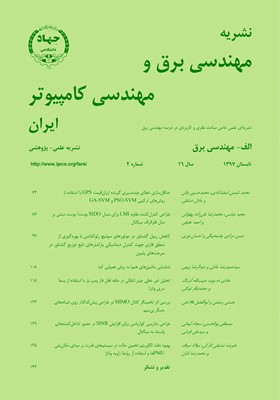طراحی ماتریس کواریانس برای افزایش SINR در حضور تداخلکنندههای وابسته به سیگنال
محورهای موضوعی : مهندسی برق و کامپیوترمصطفي بوالحسنی 1 , سجاد ایمانی 2 , سیدعلی قرشی 3
1 - دانشگاه شهید بهشتی
2 - دانشگاه صنعتی شریف
3 - دانشگاه شهید بهشتی
کلید واژه: رادار MIMOطراحی شکل موجماتریس کواریانس SINR,
چکیده مقاله :
در این مقاله، مسئله طراحی ماتریس کواریانس جهت بیشینهکردن نسبت سیگنال به نویز به علاوه تداخل (SINR) در گیرنده برای رادارهای چندورودی- چندخروجی (MIMO) در نظر گرفته شده است. هدف از این پژوهش، طراحی ماتریس کواریانسی است که دارای قابلیت حذف تعداد تداخل بیشتری در مقایسه با رادارهای آرایه فازی و روشهای اخیر طراحی ماتریس کواریانس بوده و همچنین دارای SINR بیشتری نسبت به آنها و رادار MIMO با شکل موجهای متعامد باشد. در این مقاله حداکثر SINR ماتریس پیشنهادی به شکل بسته محاسبه شده و نتایج شبیهسازی نشان میدهد ماتریس پیشنهادی علاوه بر دارابودن کارایی بهتر نسبت به روشهای موجود طراحی ماتریس کواریانس، میتواند با استفاده از چندگانگی شکل موج و با تعداد آنتنهای برابر، تعداد تداخلکنندههای بیشتری را نسبت به رادار آرایه فازی و روشهای اخیر طراحی ماتریس کواریانس، حذف کند. نتایج شبیهسازي دستاوردهاي تحلیلی ارائهشده در این مقاله را تأیید میکند.
In this paper, the problem of covariance matrix design to increase signal-to-interference-plus-noise ratio (SINR) in receiver for multiple-input multiple-output (MIMO) radars is considered. Our goal is to design a covariance matrix which can suppress more interferers compared to phased array radar and recent covariance matrix design methods. It can also result in a better SINR level compared to conventional MIMO radars. In this paper, maximum SINR of the proposed covariance matrix is calculated in closed form. Simulation results show that our proposed covariance matrix in addition to achieve better SINR performance, can suppress more interferers compared to phased array radar and recent covariance matrix design methods, by using waveform diversity with the same number of antennas. Simulation results also validate analytical achievements that presented in this paper.
[1] S. Haykin, J. Litva, and T. J. Shepherd, Radar Array Processing, New York: Springer-Verlag, 1993.
[2] J. Li and P. Stoica, MIMO Radar Signal Processing, Wiley, 2009.
[3] J. Li and P. Stoica, "MIMO radar with colocated antennas," IEEE Signal Process. Mag., vol. 24, no. 5, pp. 106-114, Sept. 2007.
[4] A. Haimovich, R. Blum, and L. Cimini, "MIMO radar with widely separated antennas," IEEE Signal Process. Mag., vol. 25, no. 1, pp. 116-129, Jan. 2008.
[5] L. Xu, J. Li, and P. Stoica, "Target detection and parameter estimation for mimo radar systems," IEEE Trans. Aerosp. Electron. Syst., vol. 44, no. 3, pp. 927-939, Jul. 2008.
[6] I. Bekkerman and J. Tabrikian, "Target detection and localization using mimo radars and sonars," IEEE Trans. Signal Process., vol. 54, no. 10, pp. 3873-3883, Oct. 2006.
[7] J. Li, P. Stoica, L. Xu, and W. Roberts, "On parameter identifiability of mimo radar," Signal Processing Letters, IEEE, vol. 14, no. 12, pp. 968-971, Dec. 2007.
[8] P. Stoica, J. Li, and Y. Xie, "On probing signal design for mimo radar," IEEE Trans. Signal Process., vol. 55, no. 8, pp. 4151-4161, Aug. 2007.
[9] P. Stoica, J. Li, and X. Zhu, "Waveform synthesis for diversity-based transmit beampattern design," IEEE Trans. Signal Process., vol. 56, no. 6, pp. 2593-2598, Jun. 2008.
[10] D. Fuhrmann and G. San Antonio, "Transmit beamforming for mimo radar systems using signal cross-correlation," IEEE Trans. Aerosp. Electron. Syst., vol. 44, no. 1, pp. 171-186, Jan. 2008.
[11] S. Ahmed, J. Thompson, Y. Petillot, and B. Mulgrew, "Unconstrained synthesis of covariance matrix for mimo radar transmit beampattern," IEEE Trans. Signal Process., vol. 59, no. 8, pp. 3837-3849, Aug. 2011.
[12] S. Ahmed, J. Thompson, Y. Petillot, and B. Mulgrew, "Finite alphabet constant-envelope waveform design for mimo radar," IEEE Trans. Signal Process., vol. 59, no. 11, pp. 5326-5337, Nov. 2011.
[13] S. Ahmed and M. S. Alouini, "MIMO-radar waveform covariance matrix for high SINR and low side-lobe levels," IEEE Trans. on Signal Processing, vol. 62, no. 8, pp. 2056-2065, Apr. 2014.
[14] A. Khabbazibasmenj, A. Hassanien, S. Vorobyov, and M. Morency, "Efficient transmit beamspace design for search-free based doa estimation in mimo radar," IEEE Trans. Signal Process., vol. 62, no. 6, pp. 1490-1500, Mar. 2014.
[15] J. Lipor, S. Ahmed, and M. S. Alouini, "Fourier-based transmit beampattern design using mimo radar," IEEE Trans. Signal Process., vol. 62, no. 9, pp. 2226-2235, May 2014.
[16] S. Jardak, S. Ahmed, and M. S. Alouini, "Generation of correlated finite alphabet waveforms using gaussian random variables," Signal Processing, IEEE Trans. on, vol. 62, no. 17, pp. 4587-4596, Sep. 2014.
[17] Y. Yang and R. Blum, "Mimo radar waveform design based on mutual information and minimum mean-square error estimation," IEEE Trans. Aerosp. Electron. Syst., vol. 43, no. 1, pp. 330-343, Jan. 2007.
[18] A. Leshem, O. Naparstek, and A. Nehorai, "Information theoretic adaptive radar waveform design for multiple extended targets," Selected Topics in Signal Processing, IEEE J. of, vol. 1, no. 1, pp. 42-55, Jun. 2007.
[19] J. Yang, Z. Qiu, W. Jiang, and X. Li, "Poly-phase codes optimisation for multi-input-multioutput radars," Signal Processing, IET, vol. 7, no. 2, pp. 93-100, Apr. 2013.
[20] J. Liu, H. Li, and B. Himed, "Joint optimization of transmit and receive beamforming in active arrays," Signal Processing Letters, IEEE, vol. 21, no. 1, pp. 39-42, Jan. 2014.
[21] A. Duly, D. Love, and J. Krogmeier, "Time-division beamforming for mimo radar waveform design," IEEE Trans. Aerosp. Electron. Syst., vol. 49, no. 2, pp. 1210-1223, Apr. 2013.
[22] S. Imani and S. A. Ghorashi, "Transmit signal and receive filter design in co-located MIMO radar using a transmit weighting matrix," Signal Processing Letters, IEEE, vol. 22, no. 10, pp. 1521-1524, Oct. 2015.
[23] R. T. Hoctor and S. A. Kassam, "The unifying role of the coarray in aperture synthesis for coherent and incoherent imaging," Proceedings of the IEEE, vol. 78, no. 4, pp. 735-752, Apr. 1990.


